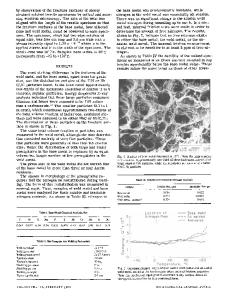STEM Analysis of primary austenite solidified stainless steel welds
- PDF / 2,387,255 Bytes
- 9 Pages / 603.28 x 788 pts Page_size
- 5 Downloads / 289 Views
I.
INTRODUCTION
THE welding
and resulting weld microstructures of austenitic stainless steels has been the object of considerable renewed interest within the last few years. It has been shown that depending upon alloy composition, the AISI 300 series alloys may solidify as either primary ferrite or primary austenite, i-5 The primary solidification mode refers to the crystal structure of the first solid to form from the liquid. Understanding of the solidification behavior of austenitic steel welds is complicated by the occurrence of a variety of ferrite morphologies. However, the Fe-Ni-Cr ternary diagram assembled by Speich6 can be used to discuss the solidification process in general terms. Figure 1 shows the liquidus and solidus surfaces of the ternary. A eutectic trough extends from near the Fe comer toward the Cr-rich comer. This diagram has been recently more thoroughly characterized by SchiJrmann and Brauckmann. 7 They found that the Fe-Ni peritectic changes to a eutectic at 75.8 pct Fe, 9.6 pct Ni, and 14.6 pct Cr. The eutectic trough terminates in a ternary eutectic at - 49 pct Cr, 43 pct Ni, 8 pct Fe. The AISI 300 series alloys contain typically 60 to 70 pct Fe with Cr and Ni contents which place them close to the eutectic region of the diagram. Compositions on the Ni-rich side of the eutectic liquidus will solidify as primary austenite. If the composition is sufficiently far from eutectic compositions, solidification will occur completely as austenite. As the compositions approach the eutectic trough, some ferrite can form during the last stages of solidification likely by the eutectic reaction. This ferrite will then be confined to the solidification cell boundaries. Alloys with nominal compositions on the Cr-rich side of the eutectic liquidus typically solidify as primary ferrite. Although it has been shown that a large fraction of the solid may solidify as primary ferrite, much of the ferrite transforms to austenite upon cooling. This transformation is a result of the nature of the 6 and 3' solvus, as can be seen from the constant Fe vertical sections in Figure 2. The transformations of the ferrite to austenite can lead to a variety of ferrite morphologies. 8'9'1~In some cases these may appear very similar (in two dimensional micrographs) to eutectic ferrite of primary austenite solidified structures. 5'11 J.A. BROOKS is Member, Technical Staff, Sandia National Laboratories, Livermore, CA 94550; J.C. WILLIAMS is President, Mellon Institute, Pittsbugth, PA 15213; and A.W. THOMPSON is Professor, Metallurgical Engineering and Materials Science, Carnegie-Mellon University, Pittsburgh, PA 15213. Manuscript submitted May 13, 1982.
METALLURGICAL TRANSACTIONS A
This paper will address mainly the case of primary austenite solidification and thus considers only alloys on the Ni-rich side of the eutectic trough. However, recently it has been found that under conditions of relatively high solidification rates, ( 1 0 3 t o 1 0 5 C per second) nominal compositions slightly to the Cr-rich side of the eutectic tro
Data Loading...











